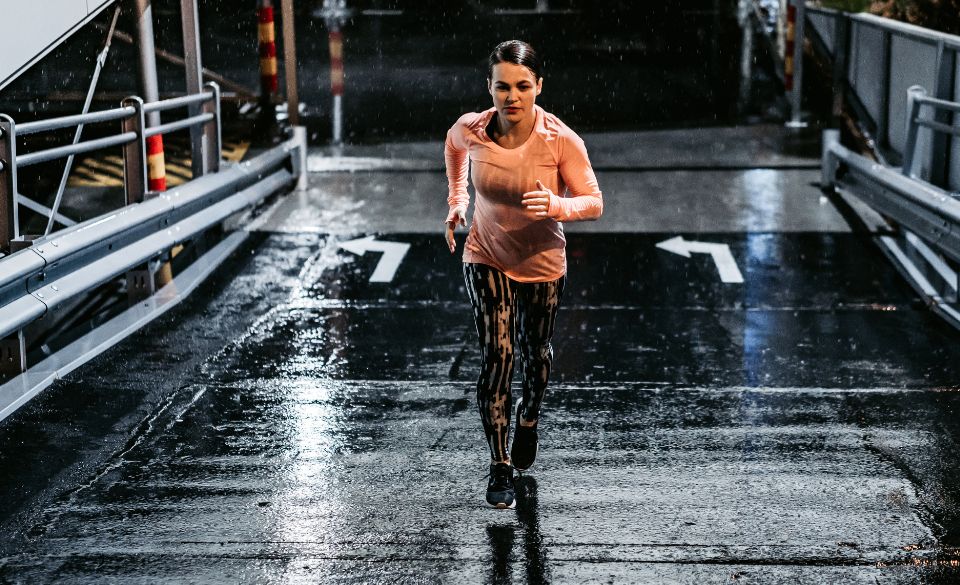
Is It OK to Run in the Rain?
Page Contents
Rainy days can present a dilemma for runners who are eager to hit the pavement and embrace their passion for fitness. The sight of raindrops falling outside the window might make you want to cozy up indoors instead of lacing up your running shoes. But before you dismiss the idea of running in the rain, let’s explore the benefits and risks involved, backed by scientific studies, so you can make an informed decision.
The Benefits of Running in the Rain
Running in the rain offers numerous benefits that can enhance your running experience and overall well-being. First and foremost, the feeling of raindrops on your skin can be incredibly refreshing and invigorating. Running in the rain provides a natural way to cool down during hot and humid weather, making your workout more comfortable and enjoyable. It’s like nature’s own sprinkler system, offering a respite from the scorching sun. The sensation of raindrops on your face and body can elevate your mood and add an element of joy to your run, turning an ordinary workout into a memorable adventure.
Beyond the physical benefits, running in adverse weather conditions like rain can build mental resilience and toughness. It requires determination and commitment to push through the discomfort and keep going despite the wet conditions. In a way, it becomes a mental challenge as much as a physical one. Embracing the rain teaches you to embrace discomfort and stay committed to your fitness goals, even when external factors may not be in your favor. Over time, this mental strength gained from running in the rain can translate into other aspects of life, helping you face challenges with greater confidence and perseverance.
Running in the rain also provides a unique opportunity to connect with nature. The sound of raindrops falling, the smell of wet earth, and the sight of glistening landscapes create a calming and meditative experience that can’t be replicated on sunny days. It’s a chance to be fully present in the moment and appreciate the beauty of the natural world around you. Rainy weather often means fewer people on the running trails or in parks, allowing you to enjoy a quieter and more peaceful run, free from the usual hustle and bustle. The rain adds an element of adventure to your workout, breaking away from your usual routine and trying something different. It fosters a sense of spontaneity and excitement, making your running journey more dynamic and enjoyable.
Moreover, running in the rain can have surprising benefits for your skin health. Rainwater contains trace minerals and natural elements that can be beneficial for your skin. As the rainwater touches your skin, it acts as a natural cleanser, washing away impurities and pollutants, leaving your skin feeling fresh and rejuvenated after your run. So, not only does running in the rain make you feel good on the inside, but it also leaves you with a healthy glow on the outside.
In addition to the physical and mental benefits, running in the rain can evoke a sense of childlike joy. It takes us back to carefree days of our childhood when playing in puddles and getting wet was pure fun. Running through raindrops and splashing in puddles can rekindle those fond memories, injecting a sense of playfulness into your workout. It reminds us that fitness and exercise can be about more than just performance; it can be an opportunity to connect with our inner child and embrace a sense of wonder.
Another surprising benefit is that running in the rain might actually help you burn more calories. The body works harder to regulate its temperature in cooler, wet conditions, resulting in increased energy expenditure. So, if you’re looking for an extra calorie burn, a rainy run might just do the trick.
Beyond the physical and mental benefits, running in the rain can also have positive effects on your mood. Rain has been linked to improved mood and reduced stress levels. The act of running outdoors in the rain can be therapeutic, lifting your spirits and leaving you with a sense of tranquility and contentment. There’s something calming and meditative about running through the rain, feeling the drops on your skin, and immersing yourself in the present moment.
Lastly, running in the rain can lead to memorable experiences. The unique and sometimes challenging conditions of running in the rain can create lasting memories that you share with friends and family. Whether it’s a comical slip on a puddle or the exhilaration of conquering a wet and muddy trail, these experiences add color and character to your fitness journey.
It’s important to note that, as with any form of exercise, running in the rain requires some caution and preparation. Be mindful of slippery surfaces, wear appropriate clothing, and prioritize safety. Checking the weather forecast before heading out is always a good idea to ensure you’re prepared for the conditions you’ll encounter.
The Risks of Running in the Rain
While running in the rain can be an enjoyable and invigorating experience, it’s essential to be aware of the potential risks involved. Here are some of the risks you should consider before heading out for a wet run:
One of the most significant risks of running in the rain is the increased chance of slips and falls. Rainwater can make roads, sidewalks, and trails slippery, making it easier to lose your footing and take a spill. The combination of wet surfaces and running at a faster pace can be a recipe for accidents, leading to injuries like sprains, strains, or even fractures. To minimize the risk of slipping, opt for running shoes with good traction and avoid running on uneven surfaces or steep hills when it’s raining.
Another risk associated with running in the rain is chafing and discomfort. Running in soaked clothing can lead to friction against the skin, resulting in painful chafing in sensitive areas such as the thighs, underarms, or nipples. To prevent chafing, it’s crucial to choose moisture-wicking clothing that draws water away from your body and reduces the risk of skin irritation. Additionally, wearing proper gear, like a lightweight, waterproof jacket, can protect you from getting drenched and uncomfortable during your run.
In some cases, running in the rain may expose you to colder temperatures, especially if the rain is accompanied by strong winds. Cold and wet conditions can lead to hypothermia, a potentially dangerous condition where the body loses heat faster than it can produce it. Symptoms of hypothermia include shivering, fatigue, confusion, and slowed motor skills. To avoid the risk of hypothermia, dress in layers and wear clothing that insulates and keeps you warm. Pay attention to weather forecasts and avoid running in heavy rain or cold temperatures if you’re not adequately dressed.
Additionally, rainy weather can lead to decreased visibility, both for you as a runner and for motorists on the road. Reduced visibility can increase the likelihood of accidents, especially if drivers have difficulty seeing you. To stay safe, wear bright or reflective clothing and accessories to make yourself more visible to others. Choose well-lit running routes and avoid busy roads during rainy conditions.
Lastly, if the rain is accompanied by thunderstorms or lightning, it’s crucial to stay indoors and avoid running outdoors until the storm has passed. Running during a thunderstorm exposes you to the risk of lightning strikes, which can be life-threatening. Seek shelter in a sturdy building and wait for the all-clear before resuming your run.
Scientific Studies on Running in the Rain
Several scientific studies have explored the effects of running in different weather conditions, including rain. These studies provide valuable insights into the physiological and psychological impacts of running in wet conditions. Let’s take a look at some of the key findings from these studies:
One study published in the Journal of Sports Sciences investigated the effects of running in hot and humid conditions compared to running in the rain. The study found that running in hot and humid weather led to higher heart rates and perceived exertion, making the workout feel more challenging. On the other hand, running in the rain was associated with reduced heat stress and perceived effort, leading to a more enjoyable running experience. This suggests that rainy runs might provide some relief from the physical strain of high temperatures, making it a favorable option during hot and humid weather.
Another study published in the International Journal of Sports Medicine explored the impact of running in different weather conditions on running performance and the risk of injury. The researchers found that moderate rain during a run did not significantly affect running performance or the likelihood of injury. However, they noted that heavy rain and slippery surfaces could increase the risk of falls and musculoskeletal injuries. The study suggests that light rain might not pose significant problems for runners, but caution should be exercised when running in more severe rainy conditions.
Furthermore, a study published in the Journal of Applied Physiology investigated how running in the rain affects body temperature regulation. The study found that runners were more susceptible to heat loss and hypothermia in wet and windy conditions compared to dry conditions. The researchers observed that rainwater soaking into clothing and skin can lead to a rapid drop in body temperature, particularly in colder environments. Therefore, it’s crucial to dress appropriately and stay mindful of the weather conditions to avoid the risk of hypothermia during rainy runs.
Despite the potential risks and challenges, some studies have also highlighted the psychological benefits of running in the rain. An article published in Frontiers in Psychology explored the effects of exercising in natural environments, including rainy weather. The researchers found that participants who exercised in outdoor natural settings reported greater feelings of revitalization and positive engagement compared to those who exercised indoors or in urban environments. Running in the rain can provide a unique and immersive connection with nature, fostering a sense of tranquility and well-being, despite the discomfort of the wet conditions.
While these studies shed light on various aspects of running in the rain, it’s essential to remember that individual experiences may vary. Factors like fitness level, clothing choices, and personal preferences play a significant role in how runners respond to rainy conditions. If you’re considering running in the rain, it’s a good idea to start with shorter runs in light rain and gradually build up your comfort level and preparedness for more challenging weather conditions.
12 Tips for Running in the Rain
Running in the rain can be an enjoyable and refreshing experience if you’re well-prepared. Here are some essential tips to make your rainy run safer and more enjoyable:
1. Wear Proper Clothing: Choose moisture-wicking and quick-drying clothing that will keep you as dry as possible during your run. Avoid cotton as it retains water and can lead to chafing.
2. Waterproof Gear: Invest in a lightweight, waterproof jacket or poncho to shield yourself from the rain. A brimmed hat or cap can also help keep rain off your face.
3. Protect Your Feet: Opt for water-resistant or waterproof running shoes with good traction to prevent slips. Consider wearing gaiters to keep water and debris out of your shoes.
4. Warm-Up Indoors: Warm up indoors before heading out for your run to get your muscles ready and reduce the chance of injury in the cold rain.
5. Mind Your Footing: Be cautious of slippery surfaces, especially painted lines on roads and metal grates. Look for areas with better traction and avoid running on steep or uneven terrain.
6. Stay Visible: Rainy weather can reduce visibility, so wear bright or reflective clothing and accessories to make yourself more visible to drivers and other pedestrians.
7. Hydration: Don’t forget to stay hydrated even in the rain. You might not feel as thirsty, but your body still needs fluids, so bring a water bottle or plan routes with water fountains.
8. Protect Electronics: Use waterproof cases or bags for your phone, fitness tracker, or any other electronic devices you carry while running.
9. Embrace the Rain: Stay positive and embrace the experience of running in the rain. Focus on the joy of being outdoors and the sense of accomplishment you’ll feel after conquering the elements.
10. Post-Run Care: After your run, change out of wet clothes as soon as possible to avoid getting chilled. Take a warm shower to warm up your body and prevent potential post-run shivers.
11. Dry Shoes and Gear: To prevent unpleasant odors and prolong the life of your running shoes, stuff them with newspaper and let them air dry.
12. Watch for Lightning: If there’s lightning in the area, avoid running outdoors and seek shelter until the storm passes. Safety should always be a top priority.
Remember, running in the rain can be a fun and memorable experience, but it’s crucial to be prepared and take necessary precautions. By following these tips, you can make the most of your rainy runs and turn them into enjoyable adventures that add a unique twist to your regular training routine.
Embracing Nature’s Gifts
Ultimately, whether to run in the rain or not is a personal choice. While scientific studies can provide insights into the physical effects, the emotional and psychological aspects of running in the rain differ from person to person. Some runners find it invigorating and enjoyable, while others prefer to stay dry and cozy indoors. Both perspectives are valid, and there is no one-size-fits-all answer.
The key is to approach running in the rain with mindfulness and preparedness. By checking the weather forecast, dressing appropriately, and understanding the risks, you can make an informed decision that aligns with your fitness goals and comfort level. If you decide to embrace the rain, allow yourself to immerse in the experience fully. Let the raindrops be your companions on the journey, refreshing your spirit and rekindling your passion for running.
Remember, running is not just about physical fitness; it’s also a way to connect with nature and find solace amidst the chaos of everyday life. So, the next time you see rain clouds gathering, take a moment to ponder the question: “Is it OK to run in the rain?” And if you feel the urge to venture out, don’t hesitate—grab your running shoes, embrace the rain, and let nature’s gifts inspire your next running adventure.




